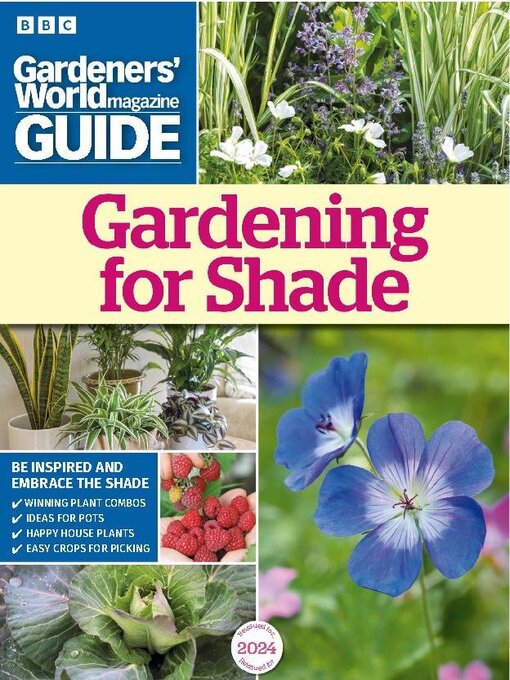Gardeners' World Magazine is the authoritative voice in gardening, the clear market-leader since it launched in 1991. The award-winning editorial includes topical, practical advice in the readers' favourite 'what to do now' section, and regular contributions and features from the top names in BBC gardening. Packed with fresh ideas and clear advice - the innovative approach offers creative, practical and problem-solving solutions to all keen gardeners.
Welcome
1 Seasonal stars Spring • Early spring is one of the easiest seasons in a shady garden, as there’s a huge range of plants to choose from. Taking advantage of the low winter light levels, they come into fower before the tree foliage shades them out, carpeting the ground with colour. These plants have to rush to achieve everything before the canopy closes over them, depriving them of light and rainfall. Seasonal favourites include dog’s-tooth violets, primulas, pulmonarias, epimediums, corydalis, brunneras, dicentra and fritillaries.
Seasonal stars Summer • With trees and shrubs in full leaf, shade often becomes more dense in summer, so your plants need to enjoy the challenge. Choose those that earn their keep by flowering over a long period, such as hardy geraniums, fuchsias and busy Lizzies, or that offer attractive foliage for many months. A vibrant multitude of greens and textures will lift any border out of the gloom. Include ferns, heucheras, hostas and alchemilla, and you’ll transform a shady patch into a summer haven, where you can relax out of the sun’s glare.
Seasonal stars Autumn • Just as some woodland plants make the most of early spring to fower before the tree foliage becomes too dense, there are others that come into their own as the leaves start to fall. Japanese anemones, ivy-leaved cyclamen and kirengeshoma burst into bloom as more light becomes available. Penstemons, sedums and colchicums are just a few of the other wonderful autumn performers. Add to this the beautiful seedheads of plants such as honesty, and the autumn shade garden is complete.
Seasonal stars Winter • To have a spectacular shady garden in winter, you need plants with berries, seed heads, flowers, evergreen foliage or architectural beauty. Try witch hazel and mahonia for bright yellow, scented flowers, hollies and skimmia for vibrant berries, and cornus for glowing stems. There are hellebores, evergreen ferns, ivies, sarcococca and viburnums, to name but a few. You can also plant bulbs in pots or in large drifts in borders – winter aconites, snowdrops and cyclamen – to light up your shade as winter comes to an end.
2 Plant solutions • Shade isn’t a drawback if you choose the right plants, so don’t be daunted by north-facing walls or dry soil under trees. We’ve selected star performers that will thrive in all kinds of tricky sites, transforming dark corners and gloomy spots with their beautiful fowers or handsome foliage.
Types of shade Know your plot • It’s vital to understand what kind of shade you have, so you can choose the right plants. Do you have dry or damp soil? And what degree of shade? This all depends on what’s casting the shade and your garden’s aspect.
Plant solutions Dry borders • Most gardens have some dry shade, maybe at the foot of a wall where the foundations draw water from the soil, or under the eaves where little rain falls. Trees also create dry shade, as their roots take up a lot of water. Finding plants that survive these conditions can be tricky, but on the following pages we give you lots of great options, from hardy geraniums, which love dappled shade, to lilyturf, which copes with most soils and conditions.
Focus on… Hellebores • Discover a range of high quality hellebores that will bloom elegantly in shady borders and pots through winter and spring
Plant solutions Damp borders • If your garden...

 Jan 01 2025
Jan 01 2025
 Year Planner 2025
Year Planner 2025
 Dec 01 2024
Dec 01 2024
 Nov 01 2024
Nov 01 2024
 Your Happy Houseplants 2024
Your Happy Houseplants 2024
 Creative Christmas 2024
Creative Christmas 2024
 Oct 01 2024
Oct 01 2024
 The Thrifty Gardener 2024
The Thrifty Gardener 2024
 Sep 01 2024
Sep 01 2024
 Aug 01 2024
Aug 01 2024
 Gardening for Shade 2024
Gardening for Shade 2024
 Jul 01 2024
Jul 01 2024
 Creative Containers 2024
Creative Containers 2024
 Jun 01 2024
Jun 01 2024
 Grow & cook 2024
Grow & cook 2024
 May 01 2024
May 01 2024
 Grow your own 2024
Grow your own 2024
 Apr 01 2024
Apr 01 2024
 Your Garden From Seed 2024
Your Garden From Seed 2024
 Your pruning Year 2024
Your pruning Year 2024
 Mar 01 2024
Mar 01 2024
 Feb 01 2024
Feb 01 2024
 Small Space Harvests 2024
Small Space Harvests 2024
 Jan 01 2024
Jan 01 2024
